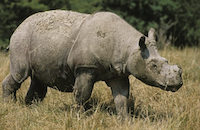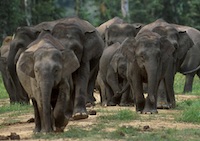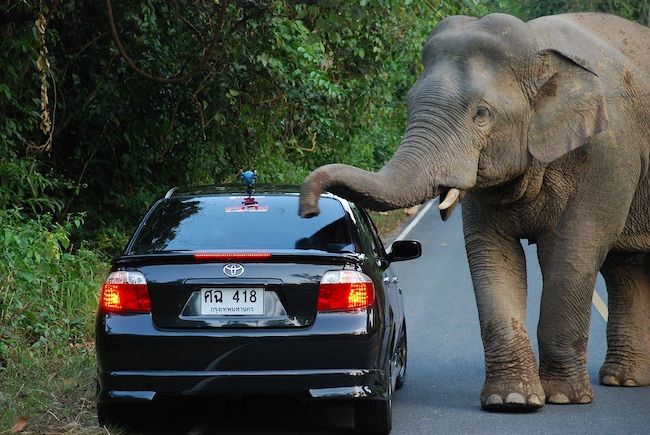







African Elephant
 |
The African elephant is one of the most iconic and recognizable animals on the planet. These majestic creatures are known for their enormous size, intelligence, and social behavior, and they play a vital role in the African ecosystem. In this article, we will explore the characteristics, behavior, habitat, and conservation status of the African elephant.
Characteristics
The African elephant is the largest land animal on earth, with males weighing up to 6.6 tons and females up to 4.4 tons. They stand at an average height of 10-13 feet and have a trunk that can reach up to 7 feet long. Their gray skin is thick, wrinkled, and provides protection from the sun and parasites. African elephants have large ears that they use to regulate their body temperature, as well as for communication with other elephants over long distances. They also have long, curved tusks, which are actually elongated incisor teeth that grow throughout their lifetime.
Behavior
African elephants are highly social animals that live in herds of up to 100 individuals, led by a matriarchal female. These herds are made up of females and their offspring, while males leave the herd when they reach adolescence and may form smaller bachelor herds. Elephants have a complex communication system that involves vocalizations, body language, and even the use of infrasonic calls that are below the range of human hearing.
Elephants are also known for their intelligence and have been observed using tools, such as branches to scratch themselves or to swat flies. They are herbivores, and their diet consists mainly of grasses, leaves, and bark. African elephants can consume up to 300 pounds of food in a day, and they require access to large amounts of water.
Habitat
African elephants are found in 37 countries in sub-Saharan Africa, ranging from the Sahel desert in the north to the rainforests of central and West Africa. They inhabit a variety of habitats, including savannas, forests, and grasslands. Elephants are considered keystone species, meaning that they play a vital role in their ecosystem by shaping the vegetation, creating watering holes, and providing food and habitat for other animals.
Conservation Status
Despite their importance, African elephants are facing significant threats to their survival. Habitat loss due to human activities, such as agriculture and urbanization, is a major concern. Additionally, poaching for their ivory tusks remains a significant problem. The illegal ivory trade has led to a decline in elephant populations, and it is estimated that there are only 415,000 African elephants left in the wild, down from an estimated 1.3 million in the 1970s.
To address these threats, conservation efforts have been implemented to protect elephant populations and their habitat. International agreements, such as the Convention on International Trade in Endangered Species of Wild Fauna and Flora (CITES), have been put in place to regulate the trade in ivory and other elephant products. Additionally, local and international organizations have established protected areas and anti-poaching patrols to safeguard elephant populations.
.
Asian Elephant
 |
The Asian elephant is one of the most remarkable animals on the planet. These majestic creatures are known for their intelligence, social behavior, and strength, and they play an essential role in the ecosystem of their native habitats. In this article, we will explore the characteristics, behavior, habitat, and conservation status of the Asian elephant.
Characteristics
The Asian elephant is a species of elephant that is smaller than its African cousin. They stand at an average height of 6-11 feet and weigh between 2.5 to 5.5 tons. Asian elephants have a gray or brown skin, which is relatively smooth with small patches of hair scattered throughout their bodies. Their ears are smaller than the African elephant, and they have a rounded forehead.
Behavior
Asian elephants are social animals that live in herds led by a matriarchal female. These herds are made up of females and their offspring, while males leave the herd when they reach adolescence and may form smaller bachelor herds. Elephants have a complex communication system that involves vocalizations, body language, and even the use of infrasonic calls that are below the range of human hearing.
Elephants are also known for their intelligence and have been observed using tools, such as branches to scratch themselves or to swat flies. They are herbivores, and their diet consists mainly of grasses, leaves, fruits, and bark. Asian elephants can consume up to 300 pounds of food in a day, and they require access to large amounts of water.
Habitat
Asian elephants are found in 13 countries in Asia, ranging from India in the west to Borneo in the east. They inhabit a variety of habitats, including tropical forests, grasslands, and dry scrublands. These habitats provide food, water, and shelter for the elephants and support a diverse range of wildlife. The Asian elephant is considered a keystone species, which means they play a critical role in the maintenance of the ecosystem.
Conservation Status
Asian elephants are facing significant threats to their survival. Habitat loss due to human activities, such as agriculture and urbanization, is a major concern. Additionally, poaching for their ivory tusks and other body parts remains a significant problem. The illegal trade in elephant parts has led to a decline in elephant populations, and it is estimated that there are only 40,000 to 50,000 Asian elephants left in the wild.
White Rhino
 |
The white rhino, also known as the square-lipped rhinoceros, is one of the largest and most iconic animals in Africa. This magnificent creature has a distinctive appearance and a complex social structure, making it a fascinating subject for researchers and wildlife enthusiasts alike. In this article, we will explore the characteristics, behavior, habitat, and conservation status of the white rhino.
Characteristics
The white rhino is a large, herbivorous mammal with a massive body and a wide, square-shaped mouth that is used to graze on grasses and other vegetation. They can weigh up to 2.3 tons and reach a length of up to 16 feet, making them the second-largest land animal after the elephant. Despite their name, white rhinos are not actually white, but rather a gray or brown color that can appear lighter in certain lighting conditions.
Behavior
White rhinos are social animals that live in groups known as "crashes." These groups can consist of up to 14 individuals, typically including one dominant male, several females, and their offspring. Within the group, the dominant male will assert his authority and protect the females from other males. White rhinos also communicate with each other through vocalizations and scent marking, using their urine and feces to create territorial boundaries and convey information about their social status.
Habitat
White rhinos are native to grasslands, savannas, and open woodlands in Africa, primarily in South Africa, Namibia, Zimbabwe, and Kenya. They require large areas of space to graze and roam, and they are well adapted to their environment, with their tough skin protecting them from thorny bushes and their long, powerful legs allowing them to move quickly over rough terrain.
Conservation Status
White rhinos are classified as a near-threatened species by the International Union for Conservation of Nature (IUCN), with an estimated population of around 18,000 individuals in the wild. The main threat to white rhinos is poaching for their horns, which are highly prized in some cultures for their supposed medicinal properties and as a status symbol. Poaching has led to a significant decline in the white rhino population, with some subspecies, such as the northern white rhino, pushed to the brink of extinction.
Black Rhino
 |
The black rhinoceros, also known as the hooked-lipped rhinoceros, is a large, powerful mammal native to Africa. It is one of the two species of rhinoceros found in Africa, the other being the white rhinoceros. The black rhino is a highly endangered species due to poaching and habitat loss, making it a conservation priority.
Characteristics
Black rhinos are smaller than white rhinos, with a shoulder height of 4-5 feet and a weight of up to 1,400 kg. They have a distinctive hooked upper lip, which is used to grasp and tear vegetation. Their skin is dark gray or black in color, and it is covered with thick folds that give the appearance of armor plating. Black rhinos have two horns, the front horn being larger and the rear horn smaller or absent altogether.
Behavior
Black rhinos are solitary animals, with the exception of mating pairs and mothers with calves. They are highly territorial, and males mark their territory with urine and feces. Black rhinos are also known for their aggressive behavior, and they are not afraid to charge at perceived threats, including humans.
Habitat
Black rhinos are found in a variety of habitats, including savannas, forests, and deserts, throughout eastern and southern Africa. They require areas with plenty of vegetation, water, and mud for wallowing.
Conservation Status
The black rhino is listed as critically endangered by the International Union for Conservation of Nature (IUCN), with a population estimated at just 5,500 individuals in the wild. Poaching for their horns, which are highly valued in some cultures for their supposed medicinal properties and as a status symbol, has been the main cause of the decline in black rhino populations. Habitat loss and fragmentation, as well as competition with livestock, have also contributed to the decline in numbers.
Conservation efforts to protect black rhinos have included anti-poaching patrols, habitat restoration and management, and captive breeding programs. Black rhinos have been successfully reintroduced to areas where they were once extinct, thanks to the efforts of conservationists. However, continued conservation efforts are necessary to ensure the survival of this species.
Pygmy Hippopotamus
 |
The pygmy hippopotamus, also known as the dwarf hippopotamus, is a small, nocturnal mammal native to the forests and swamps of West Africa. Unlike its larger relative, the common hippopotamus, the pygmy hippo is a shy and elusive creature that is rarely seen in the wild.
Characteristics
The pygmy hippo is a small, compact animal, standing about 2-3 feet tall at the shoulder and weighing between 400-600 pounds. Its skin is dark brown or black in color, and it is covered with thick, hairless skin that is oily and secretes a pinkish substance that acts as a natural sunscreen. Like the common hippopotamus, the pygmy hippo has webbed toes and spends much of its time in the water.
Behavior
Pygmy hippos are primarily nocturnal, spending most of their days resting in the shade and foraging for food at night. They are solitary animals, with the exception of mothers and their young. Pygmy hippos are territorial and mark their territory with urine and feces. They are generally peaceful animals, but they have been known to become aggressive when threatened.
Habitat
Pygmy hippos are found in the dense, moist forests and swamps of West Africa, from Liberia to Ivory Coast. They prefer areas with plenty of vegetation and water, and they are often found near rivers, streams, and swamps.
Conservation Status
The pygmy hippopotamus is listed as endangered by the International Union for Conservation of Nature (IUCN), with a population estimated at less than 3,000 individuals in the wild. Habitat loss and fragmentation, as well as hunting for their meat and ivory teeth, have been the main cause of the decline in pygmy hippo populations. Climate change and the resulting droughts and floods are also a threat to their survival.
Conservation efforts to protect pygmy hippos have included anti-poaching patrols, habitat restoration and management, and captive breeding programs. Pygmy hippos have been successfully bred in captivity, and many zoos and wildlife parks around the world have pygmy hippo exhibits. However, continued conservation efforts are necessary to ensure the survival of this species in the wild.
Common Hippopotamus
 |
The common hippopotamus, also known as the river hippopotamus, is a large, semi-aquatic mammal native to sub-Saharan Africa. It is one of the largest land animals in the world and is known for its aggressive behavior and formidable appearance.
Characteristics
The common hippo has a barrel-shaped body that is covered in smooth, hairless skin. Its skin is grayish-brown in color and secretes a natural sunscreen that protects the hippo from the sun. Hippos have four stubby legs, each with four webbed toes, and a short, muscular tail. Their eyes and nostrils are located high on their heads, allowing them to breathe and see while submerged in water. Adult hippos can weigh up to 3,000 pounds and stand up to 5 feet tall at the shoulder.
Behavior
Hippos are semi-aquatic animals that spend most of their days submerged in water to keep cool and protect their skin from the sun. They are social animals that live in groups of up to 30 individuals, led by a dominant male. Hippos are known for their aggressive behavior and can be dangerous to humans and other animals. They have sharp teeth and can move quickly on land despite their bulky appearance.
Habitat
Hippos are found in a variety of aquatic habitats, including rivers, lakes, and swamps, throughout sub-Saharan Africa. They require areas with plenty of vegetation and water, and they are often found near grazing areas for easy access to food.
Conservation Status
The common hippopotamus is listed as vulnerable by the International Union for Conservation of Nature (IUCN), with a population estimated at around 125,000 individuals in the wild. Habitat loss and hunting for their meat and ivory teeth have been the main cause of the decline in hippopotamus populations. Climate change and the resulting droughts and floods are also a threat to their survival.
Conservation efforts to protect hippos have included anti-poaching patrols, habitat restoration and management, and education programs to promote the conservation of these animals. Hippos are also protected by law in many African countries. However, continued conservation efforts are necessary to ensure the survival of this species.
Sumatran Rhino
 |
The Sumatran rhino, also known as the hairy rhinoceros, is a critically endangered species of rhinoceros that is native to the dense rainforests of Sumatra and Borneo. This species is the smallest of all rhinoceroses, with adults reaching a height of only about 4 feet and a weight of up to 1,100 kg. These animals are known for their distinctive reddish-brown fur and prominent wrinkles on their skin.
The Sumatran rhino is a herbivorous animal that feeds on a variety of plants, including leaves, twigs, and fruits. They are known to have a preference for young, tender shoots of various plant species. These animals are generally solitary, with the exception of mating and rearing offspring. They are also known to be territorial, with males marking their territory with urine and dung.
One of the main threats to the Sumatran rhino is habitat loss due to deforestation, which has resulted in the fragmentation and degradation of their natural habitats. This has caused a decline in their population, as they have been forced to compete with humans for food and shelter. Additionally, the illegal wildlife trade has contributed to the decline of the Sumatran rhino population, as their horns are highly valued in traditional medicine and as a status symbol in some cultures.
Conservation efforts are underway to protect the Sumatran rhino and their habitats. One of the main conservation strategies is to establish protected areas for these animals, where they can live and breed without interference from humans. Additionally, efforts are being made to address the issue of human-wildlife conflict by providing alternative sources of livelihood for local communities, such as eco-tourism and sustainable agriculture.
Another important aspect of conservation efforts for the Sumatran rhino is breeding programs in captivity. These programs aim to increase the population of the species by breeding them in a controlled environment and releasing them back into the wild. However, breeding in captivity is not without its challenges, as the Sumatran rhino has a slow reproductive rate and requires specific environmental conditions for successful breeding.
Borneo Elephant
 |
Cede Prudente, World Wildlife Fund, Malaysia., CC BY 2.5, via Wikimedia Commons
The Borneo elephant, also known as the Bornean pygmy elephant or Elephas maximus borneensis, is a subspecies of the Asian elephant that is found exclusively on the island of Borneo, which is shared by Malaysia, Indonesia, and Brunei. These elephants are considered the smallest of the Asian elephant subspecies, with a height of only 6 to 9 feet at the shoulder and a weight of up to 3,000 kg.
Borneo elephants are generally smaller than their mainland Asian elephant counterparts due to the limited food resources on the island. Their diet consists mainly of fruits, vegetables, grasses, and bark, and they have been known to raid crops and plantations in search of food. These elephants also require access to water sources such as rivers and streams, which are vital to their survival.
Borneo elephants are highly social animals and live in small herds consisting of females and their young. Males usually live solitary lives, except during the breeding season when they seek out females. The herds are led by a matriarch, who is usually the oldest and most experienced female in the group. Elephants have a strong sense of family and are known to mourn their dead.
Despite their importance in the ecosystem, Borneo elephants face a number of threats to their survival. Habitat loss and fragmentation due to deforestation and conversion of land for agriculture and infrastructure development are the biggest threats to these animals. Human-elephant conflict is also a major issue, as elephants raid crops and plantations, leading to retaliation from farmers in the form of killing or capturing the animals.
Poaching for their ivory tusks, meat, and other body parts is another major threat to Borneo elephants. The illegal trade in elephant parts continues to fuel demand for ivory and other products, despite efforts to ban the trade and protect these animals.
Conservation efforts are underway to protect Borneo elephants and their habitats. Protected areas have been established to preserve elephant populations, and efforts are being made to reduce human-elephant conflict by providing alternative sources of food for elephants and educating farmers on ways to protect their crops. The illegal trade in elephant parts is also being tackled through law enforcement and public awareness campaigns.